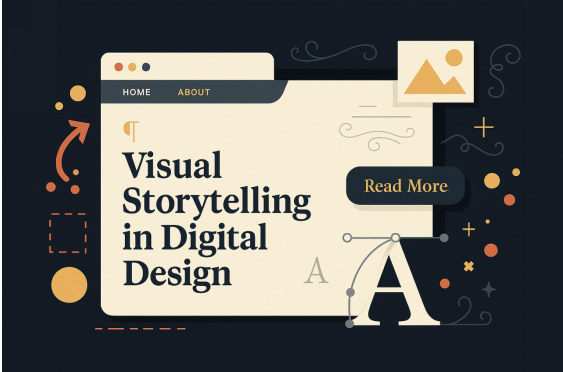Table of Contents
Introduction: Where Design Meets Emotion
In today’s digital world, every pixel has a purpose. Whether you’re scrolling through a website, exploring a new app, or interacting with a brand on social media, design is the invisible language shaping your experience. But what truly makes digital design memorable isn’t just color palettes or layouts — it’s storytelling.
Visual storytelling allows designers to turn static visuals into emotional journeys. It transforms design into a narrative that speaks directly to the viewer, helping brands express who they are and why they matter. Great digital design often depends on subtle choices like color harmony, layout structure, and even creative fonts that guide the viewer’s attention and emotions in powerful, yet seamless ways.
When design tells a story, users don’t just see — they feel. This emotional connection is what keeps them engaged, inspired, and coming back for more.
What Is Visual Storytelling in Digital Design?
At the heart of it, digital visual storytelling is using images, motion, typography and layout to tell a story or express an emotion. It’s not just what people look at but how they encounter information through design.
In contemporary UI design and UX storytelling, each image should function just like a character in a movie — taking some role in the development of the story. Colors incite emotions, shapes can assign meanings, and typography carries a voice. When they are used well together, these elements say more than words can.
Why It Matters
- Instant engagement: People process visuals 60,000 times faster than text.
- Stronger brand narrative: A consistent visual story strengthens recognition and trust.
- Better user experience: Story-driven design keeps users emotionally invested.
Building a Compelling Brand Narrative
A good brand is not solely about selling products — it communicates a vision. By way of creative direction and design communication, designers can create a brand story that audiences relate to on an emotional level.
Consider your favorite brands: Apple, Spotify, Airbnb. Each image speaks a story visually: simplicity, creativity and belonging. Their designs aren’t left to chance; they’re informed by values communicated through faithful visual storytelling.
Key Ingredients of a Strong Brand Narrative
- Emotionally aligned visuals: Choose imagery and colors that reflect brand values.
- Consistent visual hierarchy: Guide the viewer’s eye through clear emphasis and contrast.
- Cohesive tone: Use recurring patterns, illustrations, and typography styles that express personality.
When every design decision aligns with your story, your audience feels it — even without reading a single word.
Emotional Design: Creating Meaning Through Feeling
Design without emotion is decoration. Emotional design transforms aesthetics into experiences by appealing to the user’s senses and feelings.
A UX storytelling approach looks beyond functionality and focuses on how users feel while interacting with a design. For instance:
- Warm colors can create comfort and trust.
- Clean layouts evoke calm and clarity.
- Interactive micro-animations make experiences more delightful and human.
Emotional Triggers That Enhance Digital Design
- Joy: Bright visuals and playful interactions.
- Trust: Minimalistic and organized layouts.
- Excitement: Bold contrasts and dynamic visuals.
When emotions drive design, users form personal connections with brands — turning simple visuals into memorable experiences.
Visual Hierarchy: Guiding the Eye with Intention
A story without direction can confuse its audience. The same goes for design. Visual hierarchy ensures that users know what to focus on first, second, and last. It’s how designers choreograph attention.
Principles of Visual Hierarchy
- Size and scale: Larger elements attract attention first.
- Contrast: Use light and dark, bold and subtle to emphasize key points.
- Alignment: Keep balance to create flow and readability.
- Whitespace: Allow breathing room — it highlights what’s most important.
A well-structured hierarchy isn’t just aesthetic; it’s a narrative roadmap. It tells the viewer what matters and why.
Storytelling in UI and UX Design
In UI/UX design, visual storytelling acts as a mediator between usability and emotion. The best digital experience is one that feels natural — as if the interface is gently ushering you in the right direction, without using words.
For instance, an onboarding screen that rolls out like a little story can give users a sense of direction and confidence. Similarly, animated transitions from one page to the next can also help give a sense of continuity and flow, making progress feel natural.
How to Use Storytelling in UX
- Begin with a clear purpose — what do you want users to feel or achieve?
- Create emotional touchpoints at key moments (loading screens, confirmations, etc.).
- Use microcopy and visuals that speak directly to the user, not at them.
Designing for humans means designing for emotion — and that’s where storytelling thrives
Bringing It All Together: The Designer as Storyteller
Today’s designer is not only a visual maker but also a ‘storyteller.’ (I then imagined the place where all choices of buttons, transitions, and colors would have a part in it.) With creative direction and design communication, you can flesh out abstract concepts into emotions you can actually hold in your hand.
You aren’t just a designer, you’re a person who shapes experiences that draw people closer to ideas, brands, and values. That’s the power of visual storytelling, right there — it makes data meaningful and that meaning impactful.
Conclusion: Design That Speaks Without Words
Visual storytelling isn’t just a design principle — it’s the core of digital creativity. It offers brands a voice, allows users to emotionally connect with the web, and makes it easy for us to create experiences that can’t be forgotten.
So when you design a web page, logo or interface next time, think of it is a story waiting to be told. Look for the emotion, look for clarity of purpose. Let every color, line and typeface have meaning.
Your next great design isn’t just something to look at — it’s something to feel.
Explore more about visual creativity, typography, and design inspiration, and start shaping stories that resonate beyond the screen.

